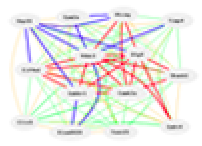Data Set Group2: UTK Spleen ILM6.1 (Jan10)

|
|
| Contact Information |
Brynn H. Voy
University of Tennessee Institute of Agriculture Knoxville
2506 River Drive 238 Brehm Animal Science Bldg
Knoxville, TN 37996 USA
Tel. 865 974-4729
bhvoy@utk.edu
Website
|
| Download datasets and supplementary data files |
|
|
|
|
| Specifics of this Data Set: |
None
|
| Summary: |
| The immune system plays a pivotal role in susceptibility to and progression of a variety of diseases. Due to its strong genetic basis, heritable differences in immune function may contribute to differential disease susceptibility between individuals. Genetic reference populations, such as the BXD (C57BL/6J X DBA/2J) panel of recombinant inbred (RI) mouse strains, provide a unique model through which to integrate baseline phenotypes in healthy individuals with heritable risk for disease because of the ability to combine data collected from these populations across multiple studies and time. We performed basic immunophenotyping (e.g. percentage of circulating B and T lymphocytes and CD4+ and CD8+ T cell subpopulations) in peripheral blood of healthy mice from 41 BXD RI strains to define the phenotypic variation in this model system and to characterize the genetic architecture that unlerlies these traits. Significant QTL models that explained the majority (50-77%) of phenotypic variance were derived for each trait and for the T:B cell and CD4+:CD8+ ratios. Combining QTL mapping with spleen gene expression data uncovered two quantitative trait transcripts (QTTs), Ptprk and Acp1, that which are candidates for heritable differences in the relative abundance of helper and cytotoxic T cells. These data will be valuable in extracting genetic correlates of the immune system in the BXD panel. In addition, they will be a useful resource in prospective, phenotype-driven model selection to test hypotheses about differential disease or environmental susceptibility between individuals with baseline differences in the composition of the immune system.
|
| About the cases used to generate this set of data: |
|
| About the tissue used to generate this set of data: |
|
| About the array platform: |
|
| About data values and data processing: |
|
| Notes: |
|
| Experiment Type: |
| Spleen gene expression was analyzed from 38 BXD strains. Adult mice (8-12 weeks) were euthanized by cervical dislocation and spleens were harvested and stabilized in RNAlater. Total RNA was extracted and gene expression profiling was performed on the Illumina Sentrix mouse-6 gene expression arrays v1.1. Each BXD sample profiled consisted of a pool of equal amounts of RNA from two individuals of the same sex and strain (approximately 15ug per strain). In addition, flow cytometry was used for the immunophenotyping of male and female mice (average of four mice/sex/strain) from 41 BXD strains (spleen expression profiling was performed on 34 of these strains) and the parental strains. Lymphoctes were identified as CD3+, CD79+, CD4+, or CD8+ to identify T cells, B cells, T helper cells, and cytotoxic T cells, respectively. These data are presented as percentage of lymphoctes with those cell surface markers (e.g. CD3%, CD79%, CD4%, CD8%). Lymphocyte subpopulations are also represented as natural log-transformed ratios (e.g. LN T:B, LN CD4:CD8). In addition, the median expression of MHCII on B cells is reported (LN MHC Med). The immunophenotype data is available in the supplementary file.
|
| Contributor: |
| Lynch RM, Voy BH
|
| Citation: |
|
| Data source acknowledgment: |
|
| Study Id: |
91
|
|
|

|
Web services initiated January, 1994 as Portable Dictionary of the Mouse Genome; June 15, 2001 as WebQTL; and Jan 5, 2005 as GeneNetwork.
This site is currently operated by
Rob Williams,
Pjotr Prins,
Zachary Sloan,
Arthur Centeno. Design and code by Pjotr Prins, Zach Sloan, Arthur Centeno, Danny Arends, Christian Fischer, Sam Ockman, Lei Yan, Xiaodong Zhou, Christian Fernandez, Ning Liu, Rudi Alberts, Elissa Chesler, Sujoy Roy, Evan G. Williams, Alexander G. Williams, Kenneth Manly, Jintao Wang, and Robert W. Williams, colleagues.
|

|

|
GeneNetwork support from:
- The UT Center for Integrative and Translational Genomics
- NIGMS Systems Genetics and Precision Medicine project (R01 GM123489, 2017-2021)
- NIDA NIDA Core Center of Excellence in Transcriptomics, Systems Genetics,
and the Addictome (P30 DA044223, 2017-2022)
- NIA Translational Systems Genetics of Mitochondria, Metabolism, and Aging (R01AG043930, 2013-2018)
- NIAAA Integrative Neuroscience Initiative on Alcoholism (U01 AA016662, U01 AA013499, U24 AA013513, U01 AA014425, 2006-2017)
- NIDA, NIMH, and NIAAA (P20-DA 21131, 2001-2012)
- NCI MMHCC (U01CA105417), NCRR, BIRN, (U24 RR021760)
|
|
It took 0.065 second(s) for tux01.uthsc.edu to generate this page
|
|







